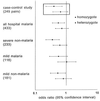alpha+-Thalassemia protects children against disease caused by other infections as well as malaria
- PMID: 9405682
- PMCID: PMC25106
- DOI: 10.1073/pnas.94.26.14736
alpha+-Thalassemia protects children against disease caused by other infections as well as malaria
Abstract
In the South West Pacific region, the striking geographical correlation between the frequency of alpha+-thalassemia and the endemicity of Plasmodium falciparum suggests that this hemoglobinopathy provides a selective advantage against malaria. In Vanuatu, paradoxically, alpha+-thalassemia increases the incidence of contracting mild malaria in the first 2 years of life, but severe disease was too uncommon to assess adequately. Therefore, we undertook a prospective case-control study of children with severe malaria on the north coast of Papua New Guinea, where malaria transmission is intense and alpha+-thalassemia affects more than 90% of the population. Compared with normal children, the risk of having severe malaria was 0.40 (95% confidence interval 0.22-0.74) in alpha+-thalassemia homozygotes and 0.66 (0.37-1.20) in heterozygotes. Unexpectedly, the risk of hospital admission with infections other than malaria also was reduced to a similar degree in homozygous (0. 36; 95% confidence interval 0.22-0.60) and heterozygous (0.63; 0. 38-1.07) children. This clinical study demonstrates that a malaria resistance gene protects against disease caused by infections other than malaria. The mechanism of the remarkable protective effect of alpha+-thalassemia against severe childhood disease remains unclear but must encompass the clear interaction between this hemoglobinopathy and both malarial and nonmalarial infections.
PIP: A prospective case-control study conducted on the north coast of Papua New Guinea in 1993-96 investigated the hypothesis that alpha(+)-thalassemia provides a selective advantage against endemic Plasmodium falciparum. In this geographic area, alpha(+)-thalassemia affects more than 90% of the population. 249 children admitted to Madang Hospital with one or more symptoms of severe malaria (severe anemia, coma, hypoglycemia, acidosis, and hyperlactatemia) were paired with 249 randomly selected healthy age- and sex-matched controls. Also enrolled were 233 children with infections other than malaria, primarily respiratory infections, gastroenteritis, and meningitis. Compared with healthy community controls, the risk of severe malaria was 0.40 (95% confidence interval (CI), 0.22-0.74) in alpha(+)-thalassemia homozygotes and 0.66 (95% CI, 0.37-1.20) in heterozygotes. The lowest odds ratios for alpha(+)-thalassemia homozygotes were recorded in the acidosis and hyperlactatemia subgroups--the two complications most predictive of malaria mortality. Unexpectedly, the risk of hospital admission with infections other than malaria was reduced to a similar degree in homozygous (0.36; 95% CI, 0.22-0.60) and heterozygous (0.63; 95% CI, 0.38-1.07) children. Although the relevant mechanism is unknown, these findings confirm a clear interaction between thalassemia hemoglobinopathy and both malarial and other infections. Given its high frequency and protective effect against malaria and some other infections, alpha(+)-thalassemia is likely to have a major impact on child survival in coastal Papua New Guinea.
Figures


References
-
- Weatherall D J, Clegg J B. The Thalassaemia Syndromes. Oxford: Blackwell; 1981.
-
- Flint J, Hill A V S, Bowden D K, Oppenheimer S J, Sill P R, Serjeantson S W, Bana-Koiri J, Bhatia K, Alpers M P, Boyce A J, Weatherall D J, Clegg J B. Nature (London) 1986;321:744–750. - PubMed
-
- Yenchitsomanus P, Summers K M, Board P G, Bhatia K, Jones G L, Johnston K, Nurse G T. Hum Genet. 1986;74:432–437. - PubMed
-
- Terrenato L, Shrestha S, Dixit K A, Luzzatto L, Modiano G, Morpurgo G, Arese P. Ann Trop Med Parasitol. 1988;82:1–11. - PubMed
Publication types
MeSH terms
Grants and funding
LinkOut - more resources
Full Text Sources
Medical

